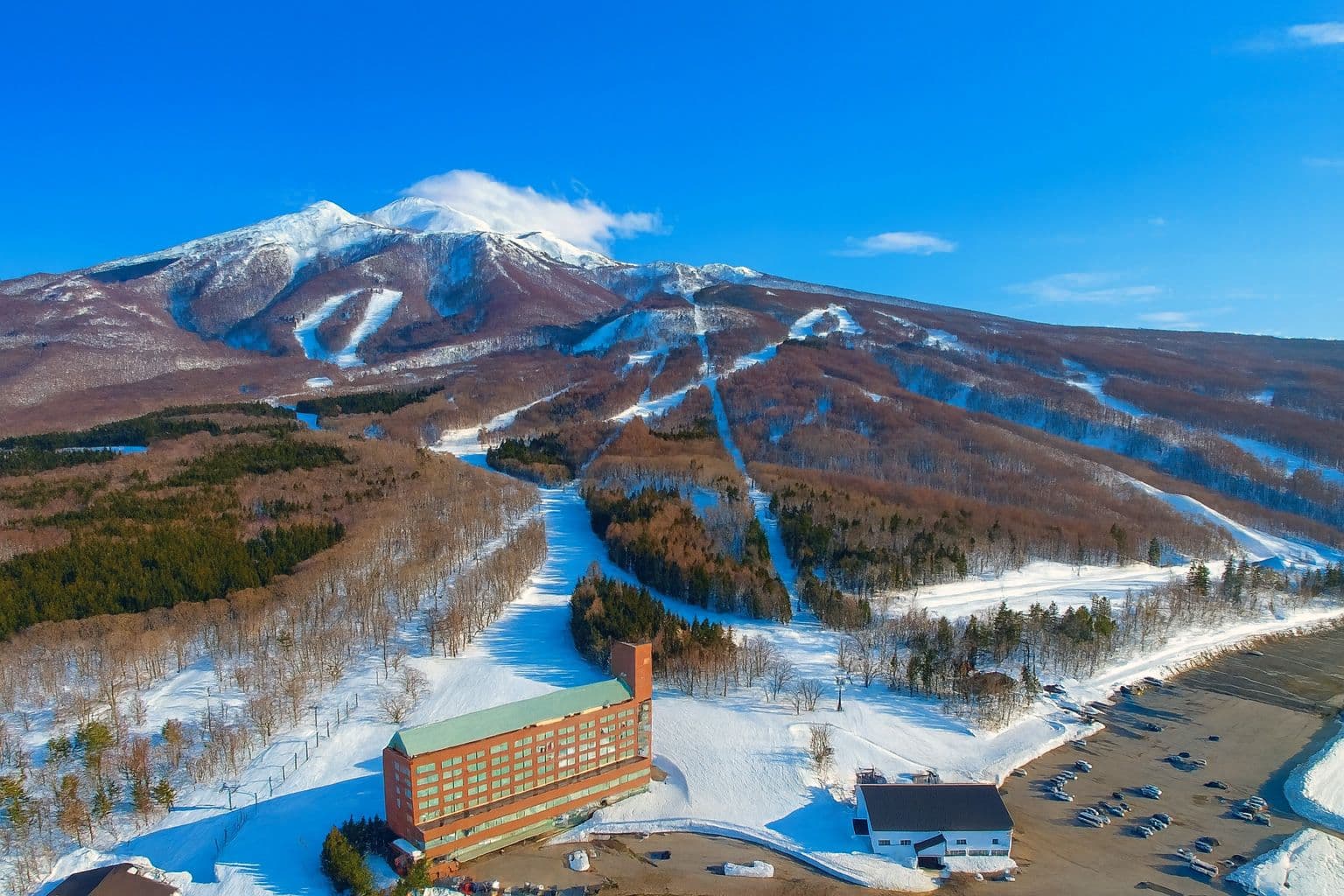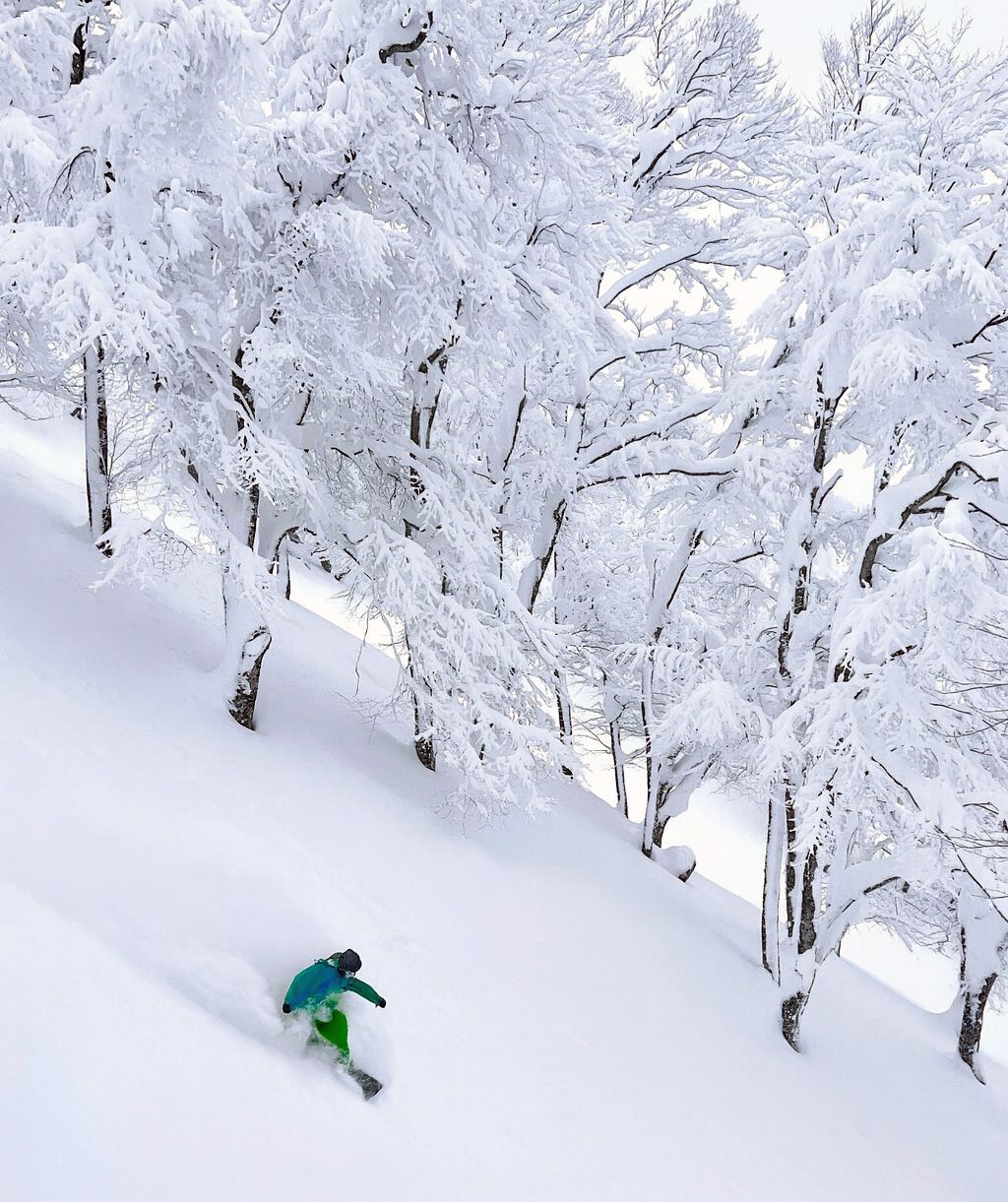Aomori Spring
Sea-view powder, beech forests, and sneaky stashes on Mt Iwaki

青森
North Shore vibes, Honshu snow
If you’ve ever stared at a map and wondered what’s brewing way up on Honshu’s northern tip, this is it: a resort tucked onto the north flank of Mt Iwaki, with the Sea of Japan shimmering out front and storm trains rolling in from behind. Aomori Spring has the feel of a purpose-built powder basecamp — a modern slopeside hotel, a gondola punching into old-growth beech, and hardly anyone elbowing you for the good stuff.

The on-piste scene is friendly and unintimidating, with long, confidence-building groomers that snake for over 3 km. That makes it a rare bird — a place where upper intermediates can clock real mileage while stronger riders peel off into the trees and come back grinning. It’s remote compared to the big-name hubs farther south, which is exactly why the snow lasts.
Culturally, it’s classic Tohoku: warm hospitality, quiet nights, serious snowfall. You’ll hear some English (especially at the hotel and with instructors), but you’re very much in Japan here — menus skew local, signs can be sparse, and the staff does a lot with smiles and hand gestures. It’s part of the charm.
Weekdays are blissfully calm; weekends pick up with local families but never feel chaotic. There’s no party village — think onsen steam, a beer in the lounge, early start tomorrow. If that’s your speed, Aomori Spring hits different.
Resort Stats
- Vertical545m (921m → 376m)
- Snowfall~10m
- Terrain 50% 30% 20%
- Tree Riding
- Lift Pass$30
- Lifts1 gondola, 2 hooded quads, 1 double
- Crowds
- Out of Boundsheed closures/signage
- Night Skiing
- Family Friendly
- Trails14
- Skiable Area~70ha
- VibeQuiet, snowy, tree-focused, no-fuss
Trail Map

Powder & Terrain
The hill rises out of beech forests, and you feel that from first chair. The gondola is the spine: ride it to the 900-ish meter ridge and you’re standing in colder air with a clear line of sight to the Sea of Japan when it’s not nuking. The groomers are legit long — perfect cord on calm mornings — but the real flavor hides between them. The pitch up top is just right for storm-day powder riding: enough gradient to keep you gliding, not so steep that it turns to survival skiing when it’s really dumping.
Lift layout is simple and efficient. The gondola handles the bulk of the vertical; two hooded quads orbit beneath, feeding a web of blue and red pistes and a bunch of gladed cut-throughs. Coverage is excellent thanks to the northerly aspect. When the wind’s up on the coast, those hoods are worth their weight in gold — you’re still lapping and stacking vertical while other mountains go on wind hold.
Tree skiing is where Aomori Spring wins hearts. The beech is mature and widely spaced in the upper zones, with lines that roll and undulate rather than cliff out. Snow stays soft late into the day because rider traffic is light and the forest does its wind-buffing magic. On storm cycles, the program is classic: stick higher, follow the subtle ribs skiers’ right off the gondola, and use the quads to recycle into sheltered gullies. When the storm breaks, short bootpacks or skins from the gondola summit open more playful shots along Mt Iwaki’s ribs — nothing too committing, but enough to scratch the explorer itch.
Backcountry potential is sneaky good on clear windows. The lifts top out around 921 m, while Mt Iwaki looms above; on safe days with stable snow, teams head a bit higher beyond the ski area’s edge to find longer pitches and old-growth alleys. It’s not a formal gate system — you’re taking on true sidecountry/backcountry. Bring a partner, beacon/shovel/probe, and the know-how to evaluate avalanche hazard. The patrol is chill about responsible egress where permitted, but rope-ducks on closed terrain will get you a firm word.
Crowd factor? Minimal. Powder hangs around far longer than you’re used to if you’ve only tasted the marquee names. Even on weekends, you can usually repeat favorite tree bands without racing anyone. The trick is timeless: be on the gondola for opening, work the fall-line zones up high, and milk the shaded beech later. If the wind’s feisty, base yourself off the lower hooded quad and stitch together protected lines until it calms.
Local tips: aim storm days at the gondola’s lee side where beech pockets trap snow, and save the middle-mountain rollers for the afternoon when legs want flow. On bluebird, sneak a short hike above the top station — just a bump — to drop into low-traffic glades that you’ll want to keep to yourself.
Who's it for?
Strong intermediates who want to taste “real Japan” without chaos will thrive — long groomers, forgiving snow, and trees that invite but don’t punish. Advanced boarders and skiers who love natural features and beech-forest lines will have a field day, especially on reset weeks. Park and pipe riders will geek out over the resort’s freestyle pedigree. If you’re after huge resort mileage or technical alpine exposure inbounds, you might feel capped after a few days — treat Aomori Spring as a powder-first base with sidecountry seasoning.
Accommodation
The anchor is Rockwood Hotel & Spa, a proper ski-in/ski-out base right on the snow. Rooms face either the Sea of Japan or Mt Iwaki, and the onsen is the post-storm ritual — outdoor tubs steaming under falling snow while you debrief the day. Dining swings from hearty buffets to Japanese bistro plates, and you can wander to the lounge for a quiet drink. It’s polished without being precious, and, for what you get, good value.
If you prefer a coast-meets-mountain vibe, Hotel Grand Mer Sankaiso sits down by Ajigasawa with big water views and classic onsen energy. You’ll trade ski-in/ski-out for seafood dinners and a slower pace; it’s an easy drive/shuttle up the hill in the morning. For budgeters or anyone road-tripping, Dormy Inn Hirosaki (and other Hirosaki business hotels) are clutch: hot spring baths, clean rooms, late-night ramen — 40–60 minutes from the resort depending on conditions, with a legit city to explore on down days.
Ryokan fans can poke around Ajigasawa for smaller inns and local baths — quieter, more traditional stays where you’ll soak, eat incredibly well, and sleep like a rock. Nightlife is subdued across the board; this is onsen, rest, repeat territory, and it suits the snow-first program perfectly.
Food & Après
On-mountain, you’ll mostly fuel at the hotel’s restaurants: a buffet hall that nails the essentials (curry, ramen, carved meats, veg, desserts) and a bistro for Japanese-Western comfort plates. The lobby bar’s perfect for a whisky or a local beer while the snow sets in for tomorrow.
Down the road, Ajigasawa’s izakaya scene is compact but tasty — think fresh seafood grilled simply, sashimi from the morning’s catch, and friendly locals. If you’re based in Hirosaki, you can stretch out with craft-beer spots and izakaya lanes near the castle. It’s not a thumping après destination, and that’s fine; the powder game here rewards early nights.
Getting There
Closest airport is Aomori (AOJ) — plan on about an hour by car or arranged transfer to the resort. From Tokyo, the shinkansen to Shin-Aomori is ~3.5–4 hours; from there it’s roughly 60–90 minutes by shuttle or car to the mountain. Hirosaki Station is the handy rail gateway; the drive/taxi from Hirosaki to Aomori Spring is about 40 minutes in good weather.
Self-drive works well if you want to hop to Hakkoda or other Tohoku hills. Winter roads are well-maintained but can glaze over on coastal blasts — snow tires are standard on rentals, and after heavy snowfall the final stretch up to the resort can be slow. Parking is straightforward.
Japow Travel Tips
- Lift hours: Typically 8:30–17:00 for day skiing; night skiing on a floodlit run usually runs 16:30–21:00 in peak periods.
- Backcountry reality: No formal gate network; sidecountry and touring above the gondola require full avy kit, partners, and decision-making. Respect closures — it’s friendly here, not lawless.
- Weather patterns: Northerly aspect + Sea-of-Japan storms = reliable refills. Wind can be a factor; the hooded quads make storm riding viable.
- Language/culture: Hotel and snow school have English; around town it’s more limited. Cash still useful. Expect genuine Tohoku hospitality.
- Nearby hits: Hakkoda (storm-day tree monsters when ropeway runs) and Owani Onsen (small and local) make great add-ons to an Aomori Spring home base.
- Freestyle cred: Historically hosted international teams with a 22-foot superpipe and park features — fun to watch, fun to ride.
Verdict: Quiet pow, big smiles
Aomori Spring is the antidote to over-hyped mayhem — a snow-sure northern outpost where you can actually hunt powder without a stopwatch. The terrain won’t overwhelm you on paper, but the beech forests, the sidecountry nibbles, and the lack of traffic add up to deeply satisfying days. Come for the snow and the serenity, soak in the onsen, and let Mt Iwaki etch itself into your memory.